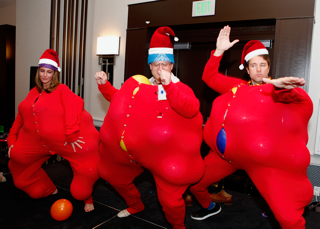Teambuilding: People are People
Building great teams has long been left to chance, or regarded as one of the dark arts shrouded in mystery. Thanks to a recent MIT study, we now know there’s a science behind it all.
It turns out the highest-performing teams have the greatest amount of casual, face-to-face interaction. Members of these teams show the greatest trust and best communication, and the best results. Get people talking, sharing, and interacting, and they strengthen as a team.
In other words: Science has shown us that people are people.
Who knew?
The Science Behind the Science
As described in a recent issue of Harvard Business Review, a team of researchers from MIT’s Media Lab invented a device to examine the real interactions among members of both high- and low-performing teams. The device is as unobtrusive as a security badge. When hung around the necks of team members during work hours, it records with whom they interact and for how long. Combined with other indirect indications, this data lets researchers track the amount, kind, and quality of interaction within teams.
The results shocked even the most-jaded managers: Informal socialization – specifically face-to-face interaction – accounted for a 35% variation in team performance, with the most-interactive teams coming out far on top.
The surest predictor of success: relaxed engagement outside formal meetings. Analyzing the data collected by the devices showed a 50% positive change in team communication patterns based on face-to-face interaction alone.
Those are numbers no one can ignore, and they drive home the importance of one oftentimes-dreaded concept: team building.
The Power of Team Building
The differences in social activity between the highest and lowest-performing teams should come as no surprise. People work together best when they get along and communicate openly. Google’s own internal research project caused them to embrace these values as their basic team performance approach, and underlies their strategy in selecting hires who are the most likely to interact openly. They call these prime candidates “the Googliest.”
However, before the MIT study’s use of digital tracking devices, even Google wasn’t able to quantify the communication differences between high- and low-achieving teams. Nor did Google offer much direction on how to build a great team once the picks-of-the-litter (the Googliest ones) have been selected. The real revelation of the MIT study is this: great teams can be created even among people who don’t stand out much on their own.
Thus, the goal for management is to bring out that elusive synergy regardless of the talents of existing members. The encouraging part of the MIT study is that we’re now able to see what goes into making a great-performing team.
Avoiding the “Corporate Stuff”
The goal of a good teambuilding should be clear: encourage relaxed, face-to-face social interaction in a way that engenders trust and easy interaction in the workplace.
However, according to a recent article in Forbes, teambuilding exercises that try to “overtly aim to draw in leadership lessons or practical takeaways” are not only least likely to be successful, but most likely to cause eye-rolling and stiff necks among the staff. These sorts of “teambuilds” are all-too-common in the corporate world.
Managerial zeal to show an ROI for every action frequently makes teambuilding, well, tedious. Poorly-executed teambuilding events often have zero or even negative effects on team performance. To function as expected, a teambuild needs to eschew the tight order and measured outcomes of the typical workplace function. This, conversely, actually allows space for indirect influences to occur more organically.
The Forbes article relates how one company turned an offsite visit to a country music concert into a successful teambuild. The kicker? The founder of the company shared his first and last names with the star performing on stage. It made for a memorable evening, and helped employees relate to each other and to their leadership.
Elements of the Best Teambuilds
Successful teambuilds take many forms, but a few characteristics are shared by all:
- Face-to-Face Interaction. “Virtual teams,” some distributed around the world, pose some difficulties for traditional teambuilding. The MIT study shows interaction via text or chat is least effective at building teams. Videoconferencing is a bit better. But consistently, teams with real face-to-face interactions in “meatspace” come out on top.
- Cultural Sensitivity. True, people are people, but not all peoples are alike. Some cultures will more strongly resist “letting their hair down” at any work-related function. Still, there are other ways to encourage interaction. This must be done wisely, and that means with an eye towards acknowledging and respecting cultural differences.
- Keep It Simple. Some tech companies try to create strong teams through regular “beer nights” or elaborate vacation-style getaways. While this has been effective in some cases, one company discovered it wasn’t working as well as expected. What worked better: Lengthening the tables in the cafeteria. Some simple teambuilding steps that only require a bit of insight.
Seek Professional Help
The benefits of great teamwork can’t be denied, and the importance of the right team environment isn’t usually up for debate. Managers (and employees) have long known that great teams are essential for great results. What does frequently get disputed: the worth of engaging a professional organization specifically to help build that team.
Thanks to the MIT study, we have numbers to prove how strongly team interaction affects real results. We also know those high-performing teams maximize face-to-face interaction in an informal setting.
The challenge is in making that happen. That’s where the help of a professional teambuilding organization comes in. Teambuilders can do more than design and organize an event to make teams more interactive: They can also suggest workplace changes to keep teams interactive once the event ends and people are back at their desks.
The professional team builder knows how to best remind team members and management of that one critical insight: People are people.





























